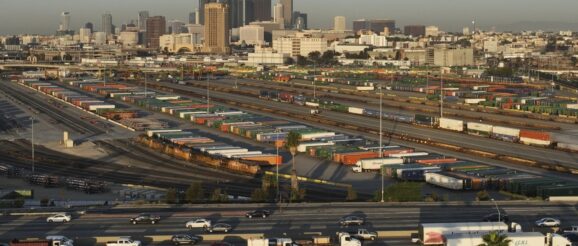A man chopped down Los Angeles trees. The crime cut deep in the struggling neighborhood

For days, police say, Samuel Patrick Groft cruised through the streets of Los Angeles on his bicycle, single-handedly chopping down about a dozen city trees with an electric chainsaw in three different neighborhoods.
Groft sometimes hacked away at large, decades-old trees in the middle of the night, others, he wielded his cordless power saw on busy sidewalks in broad daylight, according to surveillance videos reviewed by the Los Angeles Police Department.
The footage also showed that Groft’s destruction spanned at least five days, beginning on April 17 and continuing until his arrest on April 22 — Earth Day.
He has since been charged with felony vandalism and is being held on $150,000 bond. Efforts to reach Groft or an attorney were unsuccessful.
During a press conference, police said the cost of replacing the trees will be at least $347,000. But that estimate does not include three additional toppled trees discovered by the LAPD.
The root of outrage

Los Angeles Police Department
Moussavy’s videos showed several of the older trees likely measured between 20 to 30 feet — only about 5 feet of their trunks remaining in the ground. Others were cut closer to their roots.
The stories went viral, touching off tens of thousands of angry comments from users who were equally perplexed and dismayed over the loss of any piece of the city’s already meager urban canopy. In post after post they called for justice and revenge. They demanded that the culprit be forced to replant new trees.
Within days, the public outrage was so fervent that Mayor Karen Bass issued a statement calling the attacks “beyond comprehension.” She promised residents that all of the trees would be quickly replaced. No small feat in a city that’s looking to cut a billion dollars from its budget.
“I think that the uproar from everybody that we heard and saw online definitely shows how people feel when it comes to nature,” Moussavy said.
“You can replace graffiti, you can replace broken glass, but trees that take that much time to grow and honestly do nothing but provide us with a benefit … I mean at the end of the day, what did the tree ever do to you?” he asked.
Downtown’s downturn

Los Angeles Police Department
All in all, the changes have taken a toll on the 90,000 people who live downtown.
That’s why Leslie Ridings is so demoralized by this latest bout of destruction.
As co-founder of the Downtown Los Angeles Residence Association, Ridings is actively trying to build a thriving downtown community.
“Part of downtown’s job is to be a gathering place. It’s the heart of the city; We come here to watch sports games. We come here to celebrate, to mourn, and that’s awesome. We want everybody to come and spend time here and live here. We want more density, more residents. We want all of it,” Ridings said.
But a crime like this, which he described as “wanton destruction for destruction’s sake,” gives the public the impression that antisocial behavior will be overlooked.
“It really highlights the presumption of impunity,” Ridings said, adding that it also signals that city and county officials are returning to an era wherein they “used downtown as sort of the carpet they swept stuff under.”
“For how historic this neighborhood is, and how it’s been chopped down by forces that are external to it, whether it’s COVID or another economic recession,” Jurado explained.
It also serves as a metaphor for Jurado as a council member, she said.
“We’re in a crisis. Our city government is broken in this upcoming hostile fiscal environment. So much labor is being put on the table to be laid off, and our city services are being cut down even more.”
The urban canopy

The tree canopy across Los Angeles leaves a lot to be desired. A 2021 study by the city, found that 20% of the tree canopy within the city limits was located in just four neighborhoods. The research said that the root of the problem, as in many cities across the nation, stems from federal redlining policies that refused to insure mortgages in non-white neighborhoods. Over the long term, those practices have resulted in a lower investment in parks and other public green spaces. All of which confer a variety of benefits to residents.
The organization is involved in a citywide program seeking to increase the urban tree canopy “in areas with the greatest need” by 50% by 2028.
But, Vejar said, it’s not as easy as just planting new trees. Research shows Los Angeles is in desperate need of large, mature trees, which provide more shade, better storm water management and energy savings.
If there’s a silver lining to an otherwise senseless spate of arbor violence, Vejar said, the city now has an opportunity to diversify its urban forest.
The majority of the trees that were felled were ficuses. While they are often used in unwelcoming hardscaped areas because they can endure high radiant heat, they’re not native to California and can be really destructive.
Streets LA, the department that oversees public works spaces for the city, said the trees ranged in age from 10 to more than 50 years old. The agency did not give a timeline or cost estimate to replace them.
“We’re big fans of oaks,” Vejar said, noting that they are native. “We have to plant trees that are climate adaptive that can withstand some of the average heat and drought conditions that are commensurate with the built environment. And so I would advocate, not simply just for one species, but many different species.”
